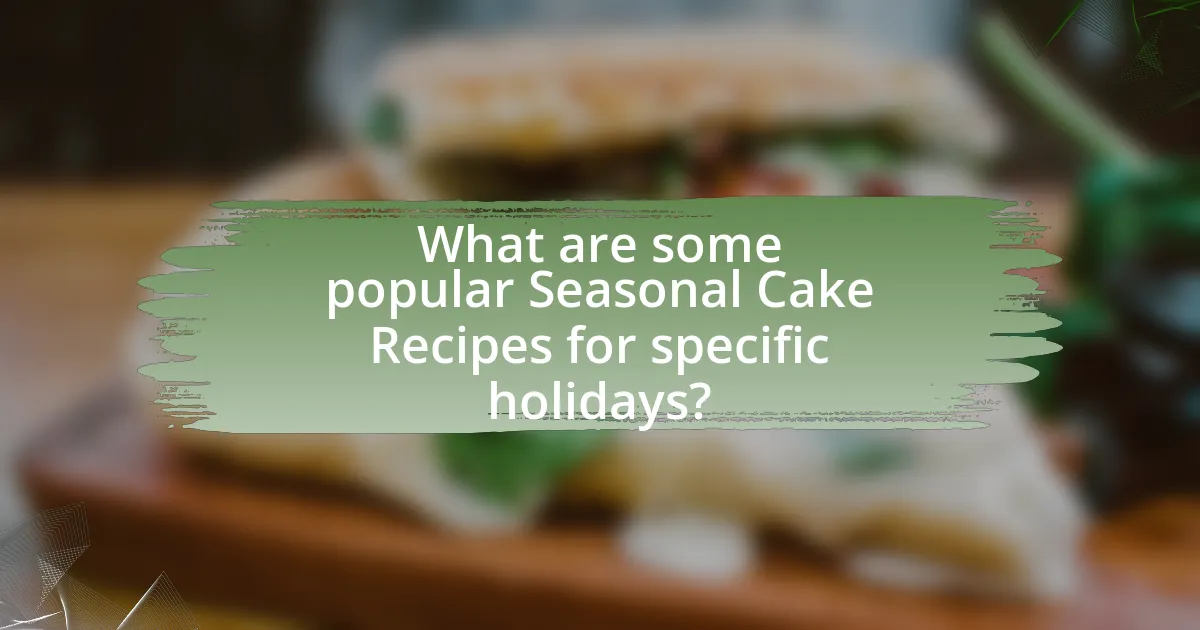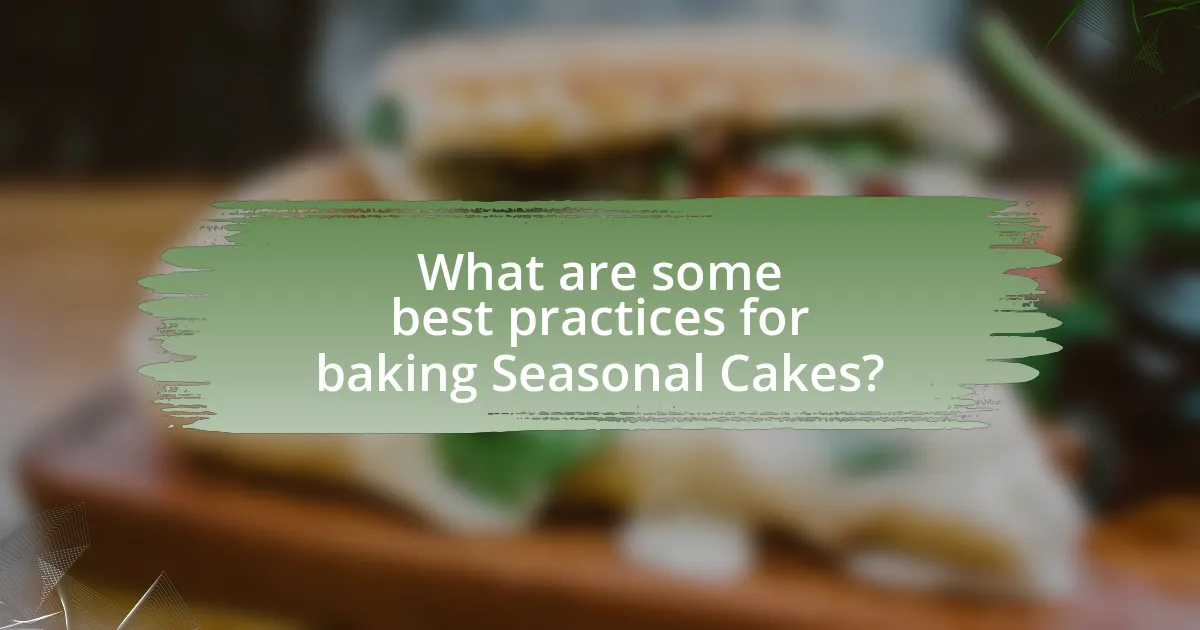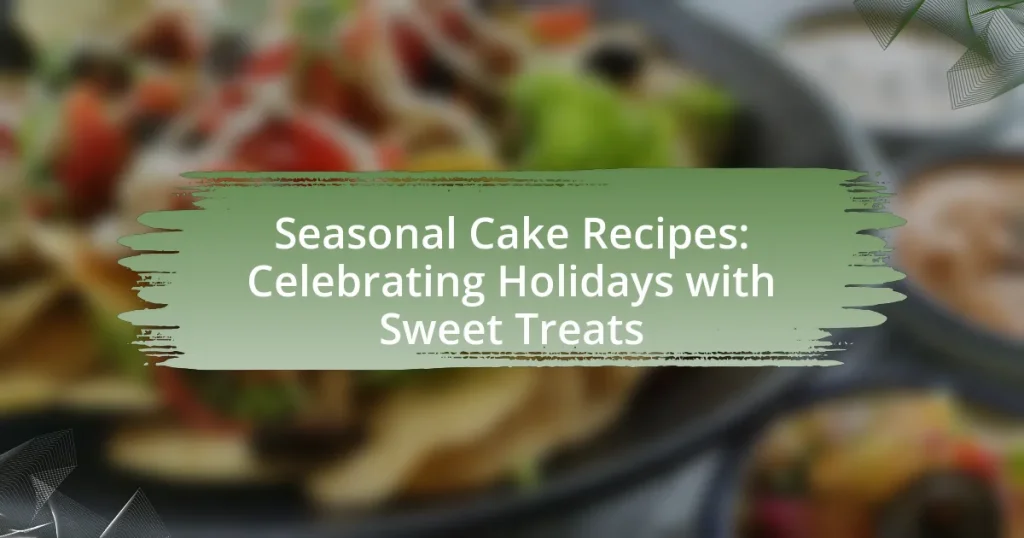Seasonal cake recipes are specialized desserts crafted to celebrate specific seasons or holidays, utilizing ingredients and flavors that reflect the time of year. This article explores how these recipes embody cultural traditions and seasonal produce, highlighting popular cakes for various holidays such as Thanksgiving, Christmas, Easter, and Halloween. It discusses common ingredients, the influence of seasonal flavors, and the significance of cakes in holiday celebrations. Additionally, the article provides insights on customizing recipes for dietary restrictions, incorporating local ingredients, and best practices for baking and decorating seasonal cakes.

What are Seasonal Cake Recipes?
Seasonal cake recipes are cakes specifically designed to celebrate particular seasons or holidays, incorporating ingredients and flavors that reflect the time of year. For example, pumpkin spice cakes are popular in autumn, while fruit cakes are traditionally made during the winter holidays. These recipes often utilize seasonal produce, such as berries in summer or citrus in winter, enhancing their relevance and appeal during specific times of the year.
How do Seasonal Cake Recipes reflect different holidays?
Seasonal cake recipes reflect different holidays by incorporating specific ingredients, flavors, and decorations that symbolize the essence of each celebration. For instance, pumpkin spice cakes are popular during Thanksgiving, representing the harvest season, while fruitcakes are traditionally associated with Christmas, symbolizing abundance and festivity. Additionally, cakes for Easter often feature pastel colors and floral designs, reflecting themes of renewal and spring. These recipes not only celebrate the unique characteristics of each holiday but also connect cultural traditions and seasonal ingredients, reinforcing the significance of these occasions in culinary practices.
What ingredients are commonly used in seasonal cakes?
Common ingredients used in seasonal cakes include flour, sugar, eggs, butter, and seasonal flavors such as pumpkin, apple, or spices like cinnamon and nutmeg. These ingredients are foundational in cake recipes, providing structure and sweetness, while seasonal flavors enhance the cake’s relevance to specific holidays or seasons. For example, pumpkin is often used in autumn cakes, particularly around Thanksgiving, while fresh fruits like strawberries or cherries are popular in summer cakes.
How do seasonal flavors influence cake recipes?
Seasonal flavors significantly influence cake recipes by dictating the choice of ingredients and flavor profiles that align with specific times of the year. For instance, autumn often features spices like cinnamon and nutmeg, while winter may incorporate flavors such as peppermint and chocolate. These seasonal preferences are rooted in cultural traditions and the availability of fresh produce, which enhances the overall appeal and relevance of the cakes during holidays. Research indicates that consumers are more likely to purchase cakes that reflect seasonal themes, as they evoke nostalgia and celebration, thereby driving sales during festive periods.
Why are Seasonal Cake Recipes important for celebrations?
Seasonal cake recipes are important for celebrations because they embody the flavors and traditions associated with specific holidays and seasons. These recipes often utilize seasonal ingredients, such as pumpkin in autumn or berries in summer, which enhances the sensory experience of the celebration. Additionally, seasonal cakes serve as a focal point for gatherings, fostering a sense of community and shared joy among participants. Historical practices show that baking seasonal cakes has been a part of cultural rituals for centuries, reinforcing their significance in marking special occasions.
What role do cakes play in holiday traditions?
Cakes serve a central role in holiday traditions by symbolizing celebration and community. They are often featured in various cultural festivities, such as birthday cakes in personal celebrations and fruitcakes during Christmas, reflecting the significance of sharing and togetherness. Historical evidence shows that cakes have been used in rituals and celebrations since ancient times, with the Greeks offering honey cakes to the gods and the Romans using cakes in their wedding ceremonies. This longstanding tradition underscores the importance of cakes in marking special occasions and fostering social bonds.
How can cakes enhance the festive atmosphere?
Cakes enhance the festive atmosphere by serving as a centerpiece for celebrations, symbolizing joy and togetherness. Their visual appeal, often decorated with vibrant colors and intricate designs, creates an inviting ambiance that encourages social interaction. Additionally, the act of sharing cake during gatherings fosters a sense of community and connection among guests. Historical traditions, such as the use of cake in weddings and birthdays, further reinforce their role in marking special occasions, making them integral to festive celebrations.

What are some popular Seasonal Cake Recipes for specific holidays?
Popular seasonal cake recipes for specific holidays include pumpkin spice cake for Thanksgiving, which features flavors of cinnamon and nutmeg, and is often topped with cream cheese frosting. For Christmas, a rich fruitcake made with dried fruits and nuts is traditional, often soaked in brandy. Easter is celebrated with a lemon cake, known for its light and refreshing taste, often decorated with pastel-colored icing. For Halloween, a chocolate cake decorated with orange and black frosting or a spiderweb design is popular. Each of these cakes reflects the flavors and themes associated with their respective holidays, making them festive choices for celebrations.
What are the best cake recipes for Christmas celebrations?
The best cake recipes for Christmas celebrations include traditional options such as fruitcake, gingerbread cake, and yule log cake. Fruitcake, often made with a mix of dried fruits, nuts, and spices, has been a holiday staple since the Middle Ages, symbolizing prosperity and good fortune. Gingerbread cake, flavored with ginger, cinnamon, and molasses, is popular for its warm spices and festive decorations. The yule log cake, or bûche de Noël, is a chocolate sponge cake rolled with cream and shaped like a log, representing the winter solstice tradition of burning a yule log. These cakes not only reflect holiday flavors but also carry historical significance, making them ideal for Christmas celebrations.
How can you make a traditional Yule log cake?
To make a traditional Yule log cake, start by preparing a chocolate sponge cake, which is typically made by whisking eggs and sugar until fluffy, then folding in melted chocolate and flour. Once baked, the sponge is rolled while warm into a log shape, then filled with a rich chocolate ganache or buttercream. After cooling, the cake is frosted with more ganache or a chocolate buttercream to resemble tree bark, and decorated with powdered sugar, marzipan mushrooms, or other festive elements. This cake, also known as “bûche de Noël,” has origins in France, where it symbolizes the Yule log that was traditionally burned during the winter solstice.
What variations exist for Christmas fruitcake?
Christmas fruitcake has several variations, including traditional British fruitcake, Italian panettone, and German stollen. Traditional British fruitcake is rich with dried fruits, nuts, and spices, often soaked in alcohol for enhanced flavor. Italian panettone is a light, airy cake filled with candied fruits and citrus zest, while German stollen is a dense, spiced cake that typically contains marzipan and is dusted with powdered sugar. Each variation reflects regional ingredients and baking traditions, showcasing the diversity of fruitcake recipes around the world.
Which cakes are ideal for Easter festivities?
Carrot cake and lemon cake are ideal for Easter festivities. Carrot cake, often adorned with cream cheese frosting, symbolizes spring and renewal, making it a popular choice during this holiday. Lemon cake, with its bright flavor, represents freshness and is commonly associated with Easter celebrations. Both cakes are frequently featured in Easter brunches and gatherings, aligning with traditional themes of the season.
What is the significance of carrot cake during Easter?
Carrot cake holds significance during Easter as it symbolizes the arrival of spring and the renewal of life. Traditionally, carrots are one of the first vegetables to emerge in spring, making them a fitting ingredient for Easter celebrations, which often focus on themes of rebirth and rejuvenation. Additionally, the use of carrots in cake can be traced back to wartime rationing when sugar was scarce, leading to the creation of sweeter desserts using available ingredients like carrots. This historical context reinforces the cake’s association with resourcefulness and celebration during the Easter season.
How can you decorate an Easter-themed cake?
To decorate an Easter-themed cake, use pastel colors, edible decorations, and symbols associated with Easter. Start by frosting the cake with light-colored icing, such as pale pink, yellow, or lavender. Then, add decorations like fondant flowers, chocolate eggs, or bunny figures to enhance the theme. Sprinkles in the shape of Easter symbols can also be used to create a festive look. According to baking experts, incorporating these elements not only makes the cake visually appealing but also aligns with traditional Easter celebrations, which often feature vibrant colors and motifs related to spring and renewal.
What unique cake recipes are associated with Halloween?
Unique cake recipes associated with Halloween include pumpkin spice cake, ghostly meringue cake, and chocolate graveyard cake. Pumpkin spice cake features pumpkin puree and warm spices, making it a seasonal favorite. Ghostly meringue cake is decorated with meringue ghosts, adding a spooky touch. Chocolate graveyard cake is often made with chocolate cake and crumbled cookies to resemble dirt, topped with candy tombstones. These recipes are popular for their thematic elements and flavors that resonate with Halloween celebrations.
How can you create a spooky cake design?
To create a spooky cake design, use dark colors like black and deep purple for the frosting and decorations. Incorporate elements such as edible spiders, ghostly figures made from fondant, and chocolate grave markers to enhance the eerie theme. Research shows that visual elements significantly impact the perception of food, with studies indicating that darker colors can evoke a sense of mystery and spookiness, making them ideal for Halloween-themed cakes.
What flavors are popular in Halloween cakes?
Popular flavors in Halloween cakes include chocolate, pumpkin spice, and red velvet. Chocolate is favored for its rich taste and versatility, often enhanced with spooky decorations. Pumpkin spice captures the essence of fall, combining flavors like cinnamon and nutmeg, making it a seasonal favorite. Red velvet, with its striking color and cream cheese frosting, adds a festive touch, appealing to those looking for a visually dramatic dessert. These flavors align with traditional Halloween themes and seasonal ingredients, making them widely chosen for celebrations.

How can you customize Seasonal Cake Recipes for personal preferences?
You can customize seasonal cake recipes for personal preferences by adjusting ingredients, flavors, and decorations. For instance, if a recipe calls for pumpkin puree, you can substitute it with applesauce for a different flavor profile. Additionally, you can modify the sweetness level by reducing sugar or using alternative sweeteners like honey or maple syrup. Flavor enhancements, such as adding spices like nutmeg or cinnamon, can also be tailored to individual tastes. Furthermore, personalizing decorations with favorite toppings, such as nuts or fruit, allows for a unique presentation. These adjustments enable the cake to reflect individual preferences while still celebrating the seasonal theme.
What are some tips for adapting recipes to dietary restrictions?
To adapt recipes to dietary restrictions, identify the specific restriction and find suitable substitutes. For example, if a recipe contains gluten, use almond flour or coconut flour as alternatives. If dairy is restricted, consider using almond milk or coconut yogurt instead of regular milk or yogurt. Research shows that ingredient substitutions can maintain flavor and texture while accommodating dietary needs, such as using flaxseed meal as an egg replacer in vegan baking. Additionally, adjusting cooking times and methods may be necessary to ensure the final product meets the desired outcome.
How can you make gluten-free seasonal cakes?
To make gluten-free seasonal cakes, use gluten-free flour blends, such as almond flour or a pre-mixed gluten-free flour. These alternatives provide the necessary structure and texture for cakes without gluten. Incorporate seasonal ingredients like pumpkin for fall or berries for summer to enhance flavor and align with the season. Additionally, ensure that all other ingredients, such as baking powder and flavorings, are certified gluten-free to avoid cross-contamination. This approach is validated by the fact that gluten-free baking requires specific ingredient adjustments to achieve the desired results, as noted in various culinary resources.
What alternatives exist for dairy in cake recipes?
Almond milk, coconut milk, soy milk, and oat milk serve as effective dairy alternatives in cake recipes. Almond milk provides a nutty flavor and is low in calories, while coconut milk adds richness and moisture due to its high fat content. Soy milk is a protein-rich option that mimics the texture of cow’s milk, and oat milk offers a creamy consistency with a slightly sweet taste. These alternatives can be used in equal measurements to replace dairy milk in recipes, ensuring that cakes remain moist and flavorful.
How can you incorporate local ingredients into seasonal cakes?
Incorporating local ingredients into seasonal cakes can be achieved by sourcing fruits, nuts, and spices that are native to the region and are in season. For example, using locally grown apples in autumn cakes or fresh berries in summer desserts enhances flavor and supports local agriculture. Research indicates that utilizing local ingredients not only boosts the freshness of the cake but also reduces carbon footprint associated with transportation, as highlighted by the USDA’s Farm to School program, which promotes local sourcing for better nutrition and sustainability.
What are the benefits of using seasonal produce in baking?
Using seasonal produce in baking enhances flavor, nutrition, and sustainability. Seasonal fruits and vegetables are typically fresher and more flavorful, as they are harvested at their peak ripeness, which improves the overall taste of baked goods. For example, using ripe strawberries in a summer cake provides a burst of natural sweetness that outperforms out-of-season alternatives. Additionally, seasonal produce often contains higher nutrient levels, contributing to healthier baked items. Research indicates that fruits and vegetables lose nutrients over time, so using them in season maximizes their health benefits. Furthermore, sourcing seasonal ingredients supports local farmers and reduces the carbon footprint associated with transporting out-of-season produce, promoting environmental sustainability.
How can local flavors enhance traditional recipes?
Local flavors can enhance traditional recipes by introducing unique tastes and ingredients that reflect regional culinary heritage. For example, incorporating local spices, fruits, or nuts into a traditional cake recipe can elevate its flavor profile and create a distinct identity. Research indicates that using locally sourced ingredients not only supports local economies but also improves the freshness and quality of the dish, as seen in studies highlighting the benefits of farm-to-table practices. This approach allows traditional recipes to evolve while maintaining their cultural significance, making them more relevant and appealing to contemporary palates.

What are some best practices for baking Seasonal Cakes?
To bake seasonal cakes effectively, use fresh, in-season ingredients to enhance flavor and texture. Seasonal fruits and spices, such as pumpkin in fall or berries in summer, provide optimal taste and moisture. Additionally, ensure accurate measurements for ingredients, as precision affects the cake’s rise and consistency. Preheating the oven to the correct temperature is crucial for even baking, and using the right baking pan size ensures proper cooking time. Finally, allow the cake to cool completely before frosting to prevent melting and ensure a clean finish. These practices are supported by baking science, which emphasizes the importance of ingredient quality and temperature control for successful cake outcomes.
How can you ensure the perfect texture in seasonal cakes?
To ensure the perfect texture in seasonal cakes, use the right balance of ingredients, specifically flour, sugar, and fat. The type of flour affects the cake’s structure; for example, cake flour yields a lighter texture due to its lower protein content compared to all-purpose flour. Additionally, incorporating the correct amount of sugar not only sweetens but also contributes to moisture retention, enhancing the cake’s softness. The fat, whether butter or oil, adds richness and tenderness; butter creates a firmer texture while oil results in a moister cake.
Furthermore, proper mixing techniques are crucial; overmixing can lead to a dense cake due to gluten development, while undermixing may result in uneven texture. Baking at the right temperature is also essential; too high a temperature can cause the cake to rise too quickly and then collapse, while too low a temperature can lead to a gummy texture.
Using these methods, such as selecting appropriate ingredients and employing correct mixing and baking techniques, will help achieve the desired texture in seasonal cakes.
What baking techniques are essential for moist cakes?
To achieve moist cakes, essential baking techniques include proper ingredient measurement, creaming butter and sugar effectively, and incorporating moisture-rich ingredients. Accurate measurement ensures the right balance of dry and wet components, while creaming incorporates air, leading to a lighter texture. Additionally, using ingredients like sour cream, yogurt, or buttermilk adds moisture and richness, enhancing the cake’s overall texture. These techniques are supported by baking science, which indicates that the right ratios and methods significantly impact the final product’s moisture content.
How does temperature affect cake baking?
Temperature significantly affects cake baking by influencing the chemical reactions that occur during the process. Higher temperatures can cause cakes to rise quickly, leading to a lighter texture, but may also result in a dry or overcooked exterior if not monitored closely. Conversely, lower temperatures allow for a more gradual rise and even baking, which can enhance moisture retention and flavor development. Research indicates that baking at the optimal temperature, typically around 350°F (175°C), ensures proper leavening and even cooking, as supported by the principles of thermodynamics in baking.
What are common troubleshooting tips for seasonal cake baking?
Common troubleshooting tips for seasonal cake baking include ensuring accurate ingredient measurements, using fresh ingredients, and adjusting baking times based on seasonal humidity and temperature. Accurate measurements prevent issues like dense or dry cakes, while fresh ingredients, such as eggs and baking powder, ensure proper rising and flavor. Additionally, seasonal changes can affect baking; for instance, higher humidity may require slightly longer baking times or adjustments in flour quantity to achieve the desired texture.
How can you fix a sunken cake?
To fix a sunken cake, you can level the top with a serrated knife and fill the depression with frosting or whipped cream. This method effectively restores the cake’s appearance and provides additional flavor. A sunken cake typically occurs due to underbaking or rapid temperature changes, which can be mitigated by ensuring even baking and avoiding opening the oven door too frequently.
What should you do if your cake is too dry?
To remedy a dry cake, you should moisten it by adding a simple syrup or a glaze. Simple syrup, made from equal parts sugar and water heated until dissolved, can be brushed onto the cake layers to enhance moisture. Additionally, incorporating ingredients like whipped cream or fruit preserves between layers can also improve texture and flavor. These methods are effective because they directly introduce moisture back into the cake, counteracting dryness.
What are some creative decoration ideas for seasonal cakes?
Creative decoration ideas for seasonal cakes include using fresh fruits, edible flowers, themed sprinkles, and seasonal colors. For instance, autumn cakes can be adorned with caramel apples and cinnamon sticks, while winter cakes may feature snowflake designs made from royal icing. Additionally, using chocolate ganache to create a glossy finish or incorporating fondant decorations shaped like seasonal symbols, such as pumpkins for Halloween or hearts for Valentine’s Day, enhances visual appeal. These techniques not only elevate the cake’s aesthetic but also align with the seasonal theme, making the dessert more festive and inviting.
How can you use edible flowers for decoration?
Edible flowers can be used for decoration by incorporating them into cake designs, enhancing both visual appeal and flavor. For instance, flowers like pansies, violets, and nasturtiums can be placed on top of frosted cakes or used to create floral arrangements around the base. Additionally, edible flowers can be crystallized for a decorative touch, adding a unique texture and sweetness. The use of edible flowers not only beautifies desserts but also aligns with trends in culinary presentation, as they are often featured in gourmet recipes and seasonal celebrations.
What are some simple techniques for festive cake designs?
Some simple techniques for festive cake designs include using fondant for smooth finishes, piping buttercream for decorative borders, and incorporating edible glitter for sparkle. Fondant allows for a polished look and can be shaped into various decorations, while buttercream piping can create intricate designs like rosettes or stars. Edible glitter adds a festive touch, enhancing the visual appeal of the cake. These techniques are widely used in cake decorating, making them accessible for both beginners and experienced bakers.




